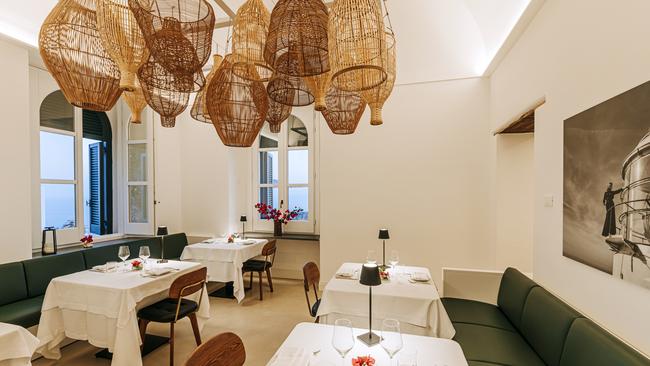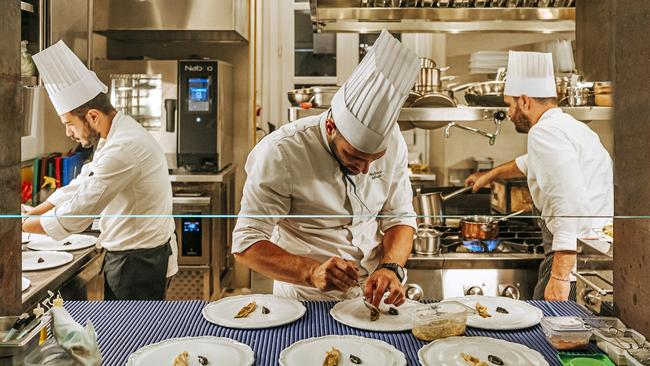This cliffside hotel in Italy illuminates a former lighthouse
I’ve stayed in some surprising hotels over the years, but few pack the wow factor like this one.
The taxi crept along a narrow country lane, up and up until it could go no further. I stood with my suitcase as the car pulled away, peering down the cliff in the darkness. The lighthouse stood in a commanding position on a steep-faced promontory, its whitewashed walls shining in the moonlight like a fairytale castle. I’ve stayed in some surprising hotels over the years, but few pack the wow factor of Faro Punta Imperatore. This four-room hideaway is the brainchild of Tim Wittenbecher, a Berlin businessman who has been obsessed with lighthouses since childhood and now has several on his books – one in Germany, one on the Baltic Sea island of Usedom, two in Spain, and this one on the Italian island of Ischia – each converted into a unique and romantic place to stay.
Early next morning I flung open the shutters onto a glorious spring day. Far below this eagle’s nest the wine-dark Mediterranean stretched away far into the distance. Over to the right, a long way down, lay Forio, one of Ischia’s bustling seaside towns, with the white church of Soccorso jutting out at the end of the bay. Apart from enjoying the views, much of my time at this extraordinary hotel would be spent wondering how on earth it actually came into being. When Wittenbecher discovered the lighthouse it had been abandoned for years and was slowly slipping into a ruinous state. There were no utilities – electricity and mains water both had to be brought in from Forio and building materials were lifted in by helicopter. Even arriving as a guest presents certain challenges: the only access to the hotel is a stone staircase that zigzags precipitously down the cliff-face (though your bags are carried up and down on a zip-wire).


If the Bond movie people are ever in search of a new location for the villain’s lair Punta Imperatore would certainly be worth a look. Originally built in 1884 to guide ships in to the Gulf of Naples, the building has a grandeur you might not expect to find in something as apparently functional as a lighthouse. The airy, vaulted ceilings of the interior, painted the same dazzling white as the outer walls, feel almost like those of a monastery. Though chic and deeply comfortable, there’s a minimalist feel to co-founder Marc Nagel’s interior design with its grey concrete floors, retro-modern furniture and weatherbeaten, rustic objects. (Check out the baskets used as a ceiling fixture in the dining room.)
For such a tiny hotel, I thought the Faro better equipped than many places five times its size. There was a sitting room with a wood-fired stove and lighthouse-related books and memorabilia on display. There was a rooftop bar for lounging with a glass of prosecco as you contemplated That View. On the ground floor there was even an in-house restaurant, Luci, where an accomplished young Ischitano chef, Antonio Monti, did remarkable things with produce sourced exclusively from the island. On the menu at dinner one night were char-grilled artichoke with black garlic, locally landed fish in a salt crust with a citrus reduction, and rabbit braised with tomato and wild thyme (this last dish an island classic). The aromatic wines of local producer Casa D’Ambra (established 1888), which uses indigenous grape varieties grown on the island’s volcanic soils, impressed me with their balsamic aromas of almonds, stone fruits and Mediterranean herbs.


You could perfectly easily spend three days simply lazing, gazing and grazing at the lighthouse – but this would be to miss out on the charms of its host island. While neighbouring Capri has historically drawn all eyes with its legendary glamour and exclusiveness, salt-of-the-earth Ischia has perhaps been unfairly ignored. Though not as tiny as Capri, the island is small enough that you can drive around its coast road in an hour and a half. Above busy little towns like Barano and Casamicciola Terme, which sprawl over the lower slopes of a long-extinct volcano, lie steeply terraced fields and verdant uplands.
A whistle-stop tour was called for. I drove out of Forio and up the west coast, stopping at an archaeological museum (Ischia was an early ex-pat colony of the ancient Greeks) and a hot-spring spa, one of several known since antiquity for their healing waters. In the villages of the interior, up towards the peak of Mount Epomeo at 789 metres, rural life went on more or less unaltered by Ischia’s sizeable tourist industry. Wherever I went, locals knew about the new hotel at Punta Imperatore and spoke of it admiringly. More than once I heard the story of Lucia Capuano, who famously took over the running of the lighthouse when, in 1937, her husband was struck dead by lightning, becoming something of a local feminist icon in the process.


The island was said to have at least two unmissable sights. One of these had been on my bucket-list for years: the glorious garden at La Mortella where composer William Walton lived with his Argentine wife, Susana, from 1949 until his death in 1983. In the 1950s Walton hired English landscaper Russell Page to design a botanical garden, which over the years has become one of the most celebrated in Italy. I wandered the stone paths among steep banks and lush borders where tropical flowers and Mediterranean shrubs grew in dense profusion. Posters announced a summer program of evening concerts in the small auditorium. In the garden restaurant, polite German and English couples picked at their lunchtime bruschetta.
The other major draw was Castello Aragonese, a medieval fortress high on a volcanic outcrop reached by a causeway from the harbour at Ischia Porto. Tourists flock to the Castello in high summer, but on this May day it was nearly deserted. I climbed to the top of the fortress and poked around the shady lanes that were like tunnels bored out of the rock, the ruined cathedral and spooky catacombs. From the quiet café where I sipped an espresso I could see right down to the pastel-painted houses of Ischia Porto and the afternoon ferry just setting off for Naples.


Back at the hotel, the sun was beginning its slow descent towards the sea. Time for an aperitivo on the rooftop, which was reached by a spiral staircase with steps of weathered white marble. The barman brought me a Campari and soda that was the exact same colour as the sunset unfolding before my Raybanned eyes. And as one spectacle ended, another began. In the glass turret above me the lighthouse swung into action, its powerful beam probing like a searchlight far across the ocean.
The writer was a guest of Faro Punta Imperatore. The hotel has four double rooms from around $600 per night. For reservations at the restaurant, Luci, call +39 081 1818 1391 or email luci@floatel.de. floatel.de
This story is from Travel + Luxury Magazine.




To join the conversation, please log in. Don't have an account? Register
Join the conversation, you are commenting as Logout